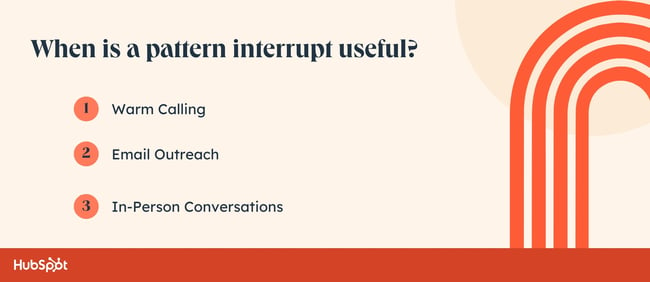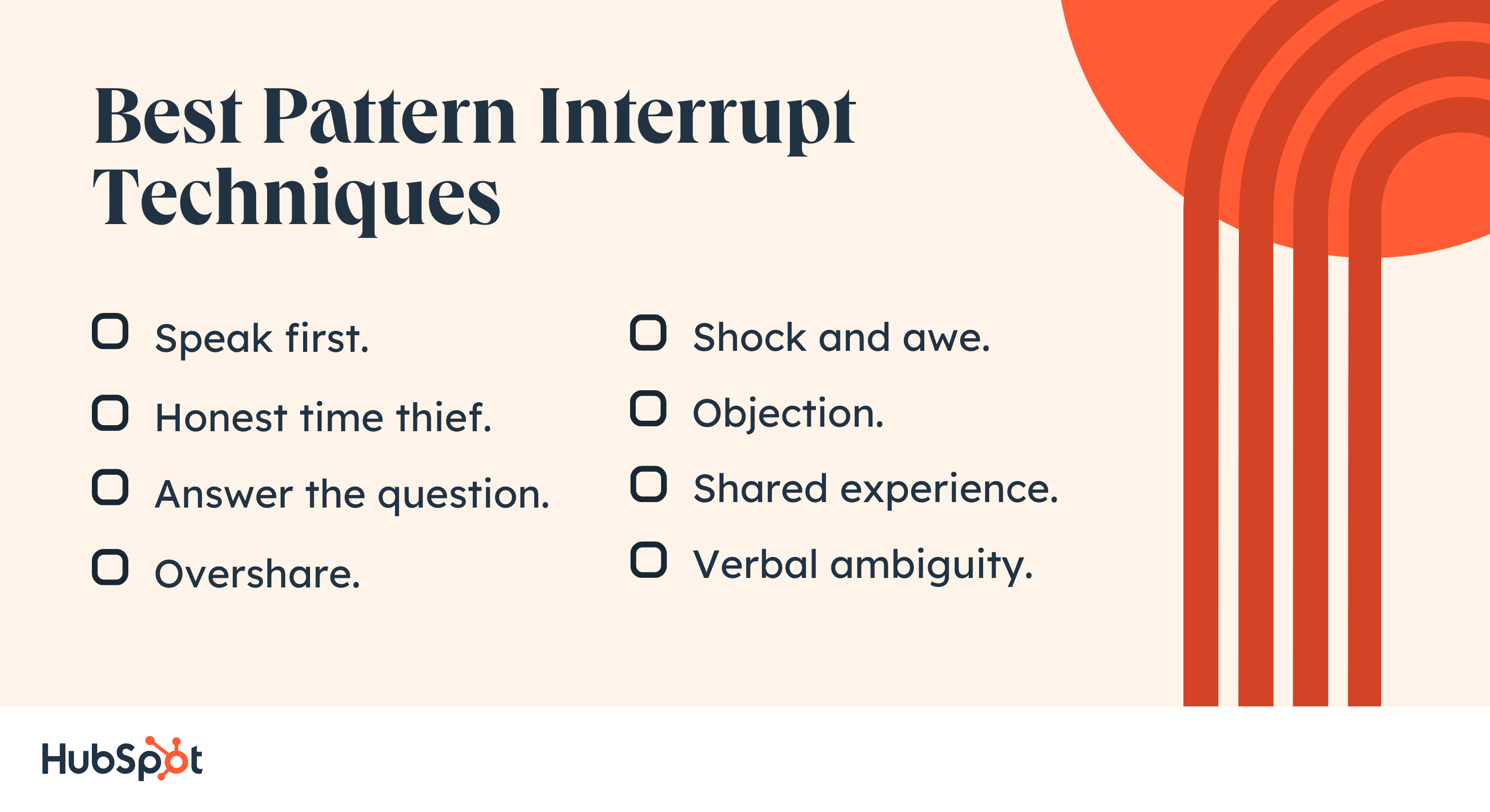Pattern interrupt is the bread and butter of any magician worth their top hat and cape. Illusionists (and salespeople!) who master these techniques can set the tone of interactions and direct the target audience's attention — to their delight and your success.

You can harness the power of psychological tools to back-guide your prospect's behavior. This can change the momentum of a conversation and engage people more effectively.
Useful at any point in the sales funnel, these techniques are often employed during the prospecting phase. It breaks habitual responses like “not interested” or “no, thanks,” giving prospects a chance to actually hear your message.
- What is pattern interrupt?
- Pattern Interrupt in Sales
- When is a pattern interrupt useful?
- Best Pattern Interrupt Techniques
What is pattern interrupt?
Pattern interrupt is a way to alter a person's mental, emotional, or behavioral state to break their typical habits. Think of it as an unexpected act that jolts them into another state of mind.
Originating from neuro-linguistic programming, pattern interrupt involves recognizing an unwanted pattern, disrupting it, and leading someone to the desired behavior. Psychologists use pattern interrupts to break people out of unwanted or unconscious responses they've developed throughout a lifetime.
A good pattern interrupt example is recognizing when you’re doom scrolling (the cue), grabbing a pair of sneakers instead (the change), and taking a walk to boost your endorphins (the reward).
There are various ways to interrupt rote responses and behaviors. Salespeople need techniques that are immediate, impactful, and that make prospects more receptive to the pitch.
Pattern Interrupt in Sales
Salespeople know the frustration of unanswered emails and unresponsive leads. Globally, people open less than 42% of the 347.3 billion emails sent daily. For salespeople, that feels like reaching into your top hat with less than a 50/50 chance of pulling out a rabbit — in front of your boss.
Pattern interrupt is an important skill to have on hand, especially during the prospecting step in the sales process, to help move sales leads down the funnel. It can stop someone from automatically saying “no” and create space for a different response.
We’ll review several techniques to make people more receptive to your email outreach, event networking, social selling, or phone calls. In all cases, your aim is the same: say something unexpected to get the person you're speaking with to pause their rote replies long enough to consider your message.
When is a pattern interrupt useful?
It’s extremely important to remember that your first goal should never be the sale; it should be the relationship. The goal is to create a positive interaction that shakes up a person‘s normal routine without making them feel uncomfortable. Like all sales techniques, there’s a time and a place to use pattern interrupts.
A poorly-timed pattern interrupt can make the person you're talking with shut down. Talking at someone instead of talking with someone leaves them feeling unheard, annoyed, and willing to do anything except buy your product to get out of the conversation.
If timed correctly, though, a pattern interrupt can spark a meaningful interaction. That‘s because when a person is guided out of their usual thoughts or behaviors, they’re left without a well-practiced and deeply-ingrained response. As a salesperson, you can fill that gap in several engaging ways.

Warm Calling
Ideally, your initial contact with a prospect isn't completely cold. You want to warm them up so that when you hop on the phone, they've heard your name before. That way, a pattern interrupts like “Hey, John. It's Jane Doe — name ring a bell?” will be more effective because they may recognize you.
You'll be able to start a conversation instead of jumping right into a pitch that they will be well-practiced at stopping at the first sniff of salesy talk.
Email Outreach
The lowest average email open rate is 18.2% (that’s via desktop as opposed to mobile, which may be useful info when considering your prospect’s demographics.) In other words, people aren't opening a majority of emails in their inboxes.
A pattern interrupt in your subject line can catch a prospect's eye and get them to click. This already puts you ahead of the pack — and makes them more receptive to your message.
In-Person Conversations
When a discussion isn't going the way you planned, you can use a pattern interrupt to redirect it and salvage the interaction for the future. Most buyers (up to 60%) only really want to talk to a sales rep during the consideration stage.
So as you look through the pattern interrupt examples below and consider which are appropriate to use in person, keep in mind that you must overcome an innate trust deficit to move forward with your unique prospect.
Best Pattern Interrupt Techniques
Every salesperson has their own one-of-a-kind list of successful techniques. These are their proven-effective tactics that mesh well with their personality, knowledge, and the unique energy that they bring to the table. It takes time and experimentation (and, yes, failure) to make your own best toolbox.
If any of these techniques are new to you, it’s worth testing out to see what helps you grab people's attention, opening the door to more meaningful and fruitful interactions.

1. Speak first.
This pattern interrupt technique isn‘t just about being the first to talk. It’s about being the first to ask a question that gets the conversation rolling and can influence the tone of the interaction.
Aim to sound familiar, casual, and genuinely interested in what your prospect has to say. It can give you valuable, personal details to fold into subsequent conversations as well. It can sound like:
- Hey Ava, how's your morning going?
- Hey Ben, this is John Doe from XYZ Company. How have you been?
- Hey Elizabeth, can you hear me okay?
Fun Fact: Sales software company Gong’s research found that “How have you been?” has a 10.01% success rate in booking a second interaction. That’s 6.6 times the average!
2. Honest time thief.
No one wants to feel like they're wasting time on a sales call, which is why this pattern interrupt technique acknowledges upfront that you’re asking for their time, and that you know their time is valuable.
The key to this method is to sound polite and professional. You might even strike a tone that sets up the prospect to wonder what's going on.
- Can I take 15 seconds of your time?
If you‘re further along in the conversation or the prospect says they don’t have time to talk, you can also use this technique to try and set up another call with your availability built in.
This also guides them to a more firm time for follow-up instead of leaving it vague, giving them room to forget you and for the lead to go stale.
- I know this call came out of the blue. When is a more convenient time to continue our conversation this Thursday or Friday?
3. Answer the question.
Everyone wants to know why they‘re speaking with someone and if the conversation is worth their time — especially if it’s someone they've never met.
This technique answers common questions right from the start, using a solution to (or acknowledgment of) their problem as the hook. You’ll need to find out which questions prospective customers ask the most, and it’s critical to know how your specific offering addresses their issue.
- Hey, Zoey — we haven’t spoken before, and I know you are busy and that I can help. Can I share why I called you today?
- Hi, John — do you know whether or not your company actually needs content marketing?
- Hey, Toby, I know organizing analytics can be a frustrating time thief — would you rather spend that time developing a strategy?
4. Overshare.
You should know a lot about your prospect before calling them, which will help you pull off this pattern interrupt example.
The idea is to let the person know that you‘ve done your research, took the time to understand their unique needs, and are ready to build a personalized business relationship that can benefit them. It’s that next-level personalization and problem-solving that makes this one stand out.
- "You mentioned how tough it is to get in front of customers during the webinar for ABC Solutions. Can you tell me why you feel that way given your experience at LMK Tech?”
5. Shock and awe.
Not every industry or person is fit for this pattern interrupt technique. It's about finding something that throws your prospect beyond the scope of normalcy into an entirely new reality. You want to jolt people into listening without crossing the line.
You might reserve this tactic for prospects that you know are feisty entrepreneurs as opposed to more conservative business owners.
- Hi! If we pretend that my product costs $2 million, would you still hear me out?
[No? Great! My product is awesome for you and doesn’t cost anything like $2 million…] - Oh wow, you picked up the phone. You just made my day.
[Um … okay … who is this?] [Whew! I’m so glad you asked …] - What would happen if the robots attacked and you lost all of your customer data?
[Um … I’d go protect my family?] [Great! While you do that, we’ll protect your data…]
6. Objection.
At least 50% of your prospects are not a good fit for what you sell — but some of the half that truly could benefit from your offering are too quick to assume that. When a prospect asks why they should buy from you, you can use this pattern interrupt to back-lead them.
Acknowledge it might not be the right fit, even if you know it likely is. This gives you a chance to address the common reasons why people don't want to buy. It allows you to remove the barriers your prospect has built up in their minds.
- I don‘t know if our product is right for you. Can I ask a few questions to check if we’re a good fit?
- I‘m sure you’re being taken care of by your current provider, but…
- I know there is some amount of stress around changing services, and it’s okay to tell me “no” if you don't think we can do a better job. The thing is, I truly think you’ll find it’s worth it if you consider…
7. Shared experience.
It can be tough to sell to people who have been in an industry for decades. But if you're in the same industry as a prospect, you can use this pattern interrupt technique to find common ground. This works especially well in B2B sales or when pitching to people in your industry.
- From one marketer to another…
- You know better than anyone that selling can be a struggle…
- I noticed we both went to the QRS Conference last month...
8. Verbal ambiguity.
This pattern interrupt relies on confusion, so it's a delicate technique. You have to be confident when delivering it and know your audience — direct communicators with lots of experience can sense this tactic and won’t tolerate it.
The aim is to say something that temporarily throws the conversation off-topic, giving you the chance to redirect it. You might say:
- "When was the last time your customer service team performed better than the last time they performed the best?"
This will cause the prospect to momentarily pause their own thought process in an effort to understand your question. This provides you an opportunity to redirect the conversation away from the excuse they were trying to present beforehand.
Another way to work this pattern interrupt is to act like you‘re the one who’s confused. This allows the prospect to seemingly take charge of the conversation as they explain an aspect of their company. This mindset shift can open them up to different ideas and responses as you continue the conversation.
- You can say, “I’m a bit confused. Can you explain why that process is so important for your company?”
Keep Your Tone in Mind
Be sure you experiment to see which pattern interrupt techniques work best for your selling personality, industry, and prospects. As you do, remember to keep your tone in mind so you don't come off as condescending or pushy.
You are offering solutions to problems in order to help people. It should be exciting to share and a relief to hear — not an exercise in drudgery for you or your prospect.
Research who you‘re talking to beforehand and have a few techniques ready to try out. In time, you’ll find the best pattern interrupt techniques to add to your toolkit.



![22 Best Sales Strategies, Plans, & Initiatives for Success [Templates]](https://blog.hubspot.com/hubfs/Best-Sales-Strategies-1.png)

![7 Social Selling Trends to Leverage This Year [New Data]](https://blog.hubspot.com/hubfs/social%20selling%20trends.png)
![How Do Buyers Prefer to Interact With Sales Reps? [New Data]](https://blog.hubspot.com/hubfs/person%20phone%20or%20online%20sales%20FI.png)
![7 Sales Tips You Need to Know For 2024 [Expert Insights]](https://blog.hubspot.com/hubfs/Sales%20Tips%202024%20FI.png)


![10 Key Sales Challenges for 2024 [+How You Can Overcome Them]](https://blog.hubspot.com/hubfs/sales%20challenges%20FI.png)
![The Top Sales Trends of 2024 & How To Leverage Them [New Data + Expert Tips]](https://blog.hubspot.com/hubfs/sales-trends-2023.png)